Como Hotels
|
I have been studying the hotels in Como in the DSP&P RR years and I an of the view that the first stage of the DSP&P hotel was as set between the pen and pencil points as shown in the photo below.
This sets out a equilibrium to the two additions each side. The first addition then would be to the left or North side and not having the dates but if my research is correct, this extension would have been announced most likely in late 1880-early 1881. This extension would have joined the two hotels together. I can go into much greater details later regarding this. The second stage I believe would have encompassed the first stage to the North side inclusive but would have been the kitchen (diner) on the South side. Thus 99&1/3 feet long. 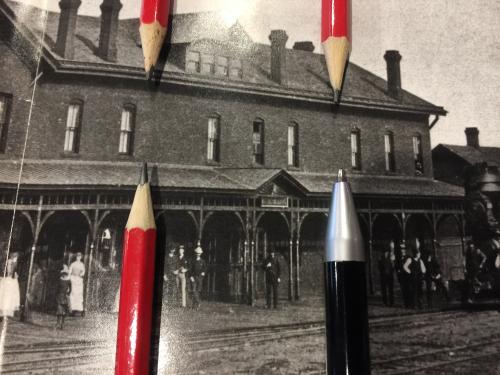 Below is a close up of the hotel under construction for comparison and I would like to explain a few things like why the door entrance is to the left side of the first stage. Stepping inside this building according to the B,B&S you would enter a single dining room measuring 28 x 42 ft. Comparing the two photos now, you will recognise that the middle window which is open in the Pacific Hotel photo was originally going to be a door. That window will be to a hallway, 4&3/4 ft wide x 42&2/3 ft long. Of coarse, there would have been originally planned a row of windows down each side of the hall. I am putting the slightly longer hall down to the probability that the first floor timber framework being of a larger size to that of the upper floor. To support the second floor. So, upon entering the hotel the division of diners and hotel guests would be a priority. Immediately to the right upon entry would be a staircase which will have had a double winder or landing to return and meet the upstairs East West hallway. 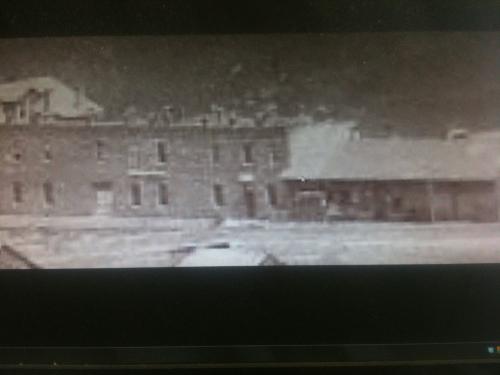 Understanding the hotels was my real foot in the door into understanding Como. I have much more that I can explain but this is enough to start with. Thanks, John |
|
I will just show you something else for I don't know if this has been noticed.
In the photo of the kitchen (diner) extension in the previous post there was a door entrance. There was also a banner hanging from a pole above the door. This suggests to me it may have served as a (diner) as well as servicing the Hotel Dining room. But by the time the Pacific Hotel burned down, the doorway had been bricked closed.  John |
|
B,B&S lists a hallway on the second floor of the Pacific Hotel measuring 6 x 98.5 ft.
The length of the extension being 99&1/8ft. A difference by my calculation of 7.5 inches. An article in the Bogie & Loop listed the extension as being 99&1/3 ft. A difference then of ten inches by my calculation. The latter makes sense to me as ten inches would be the approximate thickness of a single wall of brick and timber frame. The northern end of the hallway of coarse being of the existing Gilman Hotel and therefore not requiring an additional wall. And so the step in the hotel front becomes recognised as the two original hotel fonts were not built to be in line. Of coarse, the hallway ran behind the row of bedrooms which faced the front of the building. And it would be a natural and logical thing to do to provide a window in the south end for both light and ventilation. Same as the hallway that I described running East West through the original DSP&P Hotel. And so I went looking to see if I could find this window. And I could just see the top of the window behind the depot's roof ridge line. 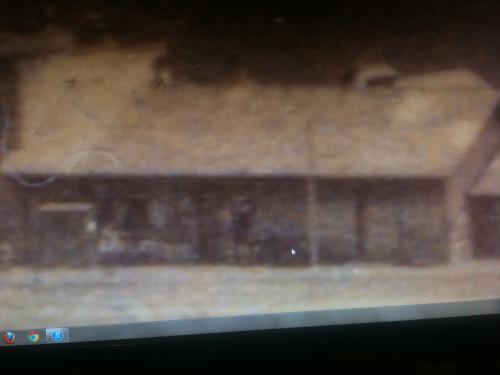 John |
|
Let me help dissolve some some misunderstandings. In regards to perceptions of DSP&P RR history that is!
The photo below would show a shadow line if there was a narrow void joining to the said Gilman Hotel. The sun is casting a shadow from the south. There is no shadow revealing a void. There was no void. 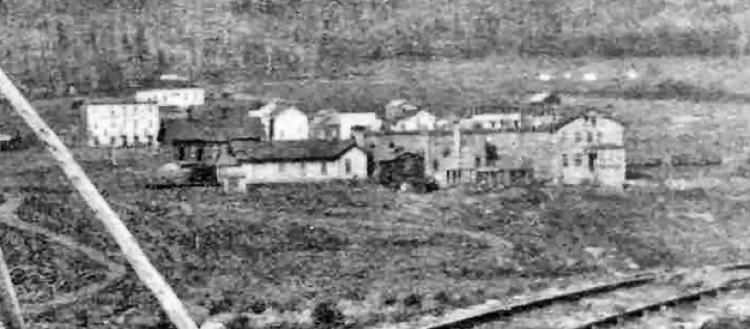 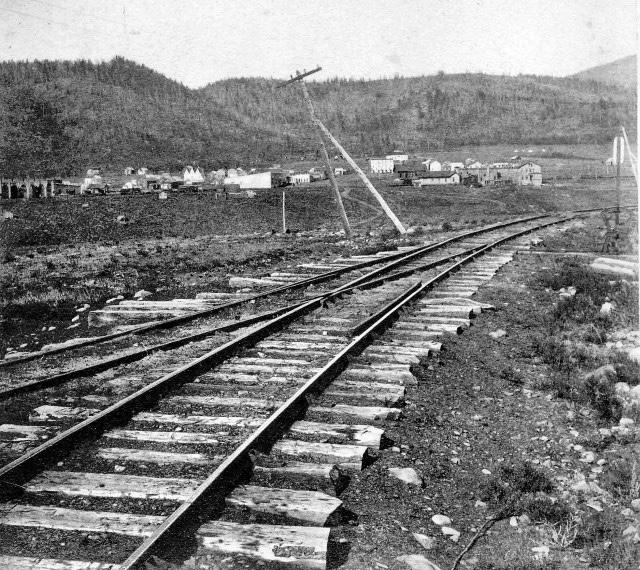 Perhaps you still prefer to think that the addition according to the B,B&S book measuring 20&1/8 x 30 ft was behind the original DSP&P hotel. It would have been then an addition to enlarge a dining room on a building only just built. It would mean removing the lower floor wall of a double story building to do so. And so I have to ask to question the rational. Look how the building on the south end which served as the kitchen or diner is deeper than the extension joining the two hotels. The extension between the two original hotels was the said as recorded 20&1/8 ft deep. Consider this also please. The Dining room was 42ft deep inside. Roughly then 43.5 ft deep outside measurement. The joining extension, 20&1/8 ft deep which is just shy of half of the 43.5 ft. And so I have to ask. If this rear wall was not eventually extended up, what would have supported the roof ridge line in this narrow area? A narrow void would not have. Before I leave off on these photos above. What I describe above is there to see and common sense. What I describe below is speculation from a number of observations. When I opened the map/plan of Como issued by Mike Blazek it only took me seconds to recognise that the Right of Way was built over an existing town plan. I observed that the Gilman Hotel basement was entirely below ground level on the inside of and in the middle of a long sweeping curve (track 1). And I had to ask myself, Why dig out a freshly formed Right of Way to build a hotel like this? I noticed that the old Highway originally headed directly for the Gilman. And as buildings were added south of the Gilman, additional reroutes of the highway were made to cross the RoW. I noticed that the main road heading South out of Como started at the exact location of the Gilman. I noticed that the road that came from what I suspect were the mines west of Como almost but not quite ran towards the Gilman Hotel. And so given that juncture of roads and the partially buried Gilman, I would predict that if that old highway had of gone straight to the Gilman and ongoing, it would be in the direction of where the railroad went in that direction as well. In short, I feel very confident that at a minimum, the basement of the Gilman was already there. And so I ponder. Was the Gilman by another name and the hotel structure which was known as the DSP&P hotel started off as the Gilman hotel construction before changing names. I don't know. But I am inclined to dismiss coincidences. Hopefully though I have my head on my shoulders, John |
|
I think I have established that the Hallway of the DSP&P Hotel had to break through the wall of the Gilman Hotel.
Windows would have to be removed. I will discuss this in a few posts but here is a close up of the Gilman windows from a DPL photo of the DLG era.  Not just because the windows match in shape, I am confident that the Gilman windows were reused in the Switchman's shanty. I can and I will bring all that together and I suspect you will find it fascinating. 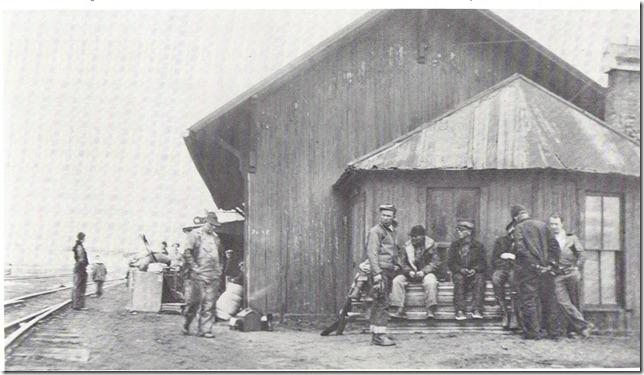 I think it a good time to acknowledge the hard work of the inverted one and his backers. Yes, I understand that the country lines did not use TOB's until much later on. No argument. But the city of busy Denver? With many railroads sharing both rail and premises? I have learned more over the years and have more to share on this related matter. Thanks, John |
|
Studying the Como Hotels has lead me to a surprising observation of this photograph.
 I had already made the comment a decade or so ago that this photo told the whole history of the Como depot. I surprise myself at just how accurate the statement is. What I had observed previously, before I proceed: Having worked in and around the building industry since leaving school, I realised that the window had been inserted into the wall to the left at a later date. The block next the window architrave revealed that to me. The head of the window frame will extend beyond the outside edge of architrave and so the block will have been placed there to cover the hole. Other side out of view is the same. I noticed that the lining on the roof ran in the opposite way than it should be, according to the direction of the roof ridge line. The roof lining in the baggage room in the photo below is running in the correct direction. This was just one of the clues that showed me that the roof over the office had been altered. I had pointed out the extraordinariness of the pieces of wood used for the telegraph wires board being fixed into the corner even before the corner bead had been attached. I had pointed out that these pieces of wood were the exact same hight as a hole in the wall further along and in line in the baggage room. Photo below. And again in the wall in-between, the same again except the hole was covered with a piece of tin. Photo below. And I also observed that these holes and and the cog bracket from the Train Order Board were at the exact same hight as well. And the holes were the same width to boot. See Photos below. But the reference point being the hole in the wall surrounded by three bolts. Where the shaft of the TOB passed through. And for future reference, the horizontal shaft was attached to the bottom of the eaves which determined its maximum allowable hight. So what is it that I discovered? It is to do with my last post and the reference to windows being removed from the Gilman and used in the Depot. I realised that these three pieces of wood used for a telegraph wires entrance are pieces of wood from a window surround. I will describe each top to bottom. The top piece with the holes drilled in it identifiable with the cove just in view on the end is now upside down to its former use. Previously it butted up underneath a window frame. The bead still nailed to it at the time the photo was taken, formerly butted up against the bullnose of the window sill. Picture in your mind the carpenter having to place the bead in the very corner. He would have flicked his hammer against this window sill bead and snapped it away at the nearest nail. And that's how it sat until the depot was renovated. The next piece of wood is easy judging from the shape and the mitre on the end. It was a piece of architrave. And a quick note for future reference, there are only two other pieces of architrave like this in the depot. And they are on the ceiling and wall in the green painted baggage room. I will return to this. The third piece of wood is also removed from a window. A similar shape is in the window to the left. None of the three pieces match that of the window to the left. That is because this was the interior architecture of the Gilman Hotel. And so I will discuss further below the two pieces of Gilman architrave situated in the baggage room.  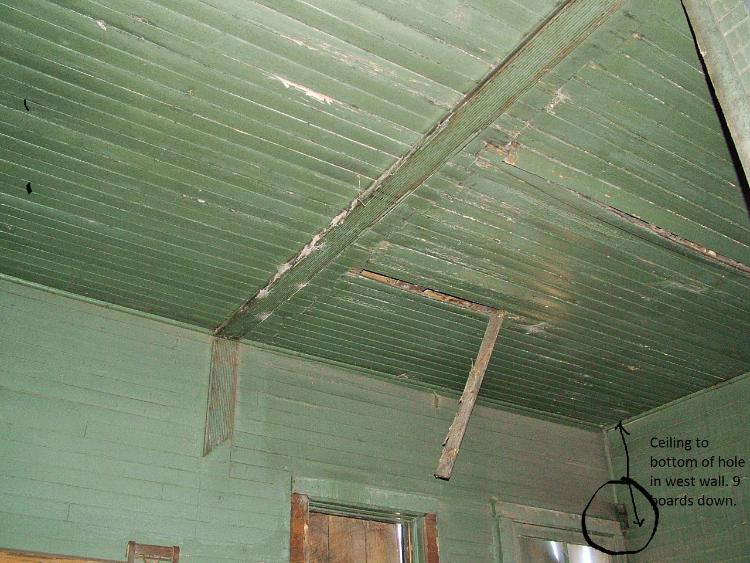  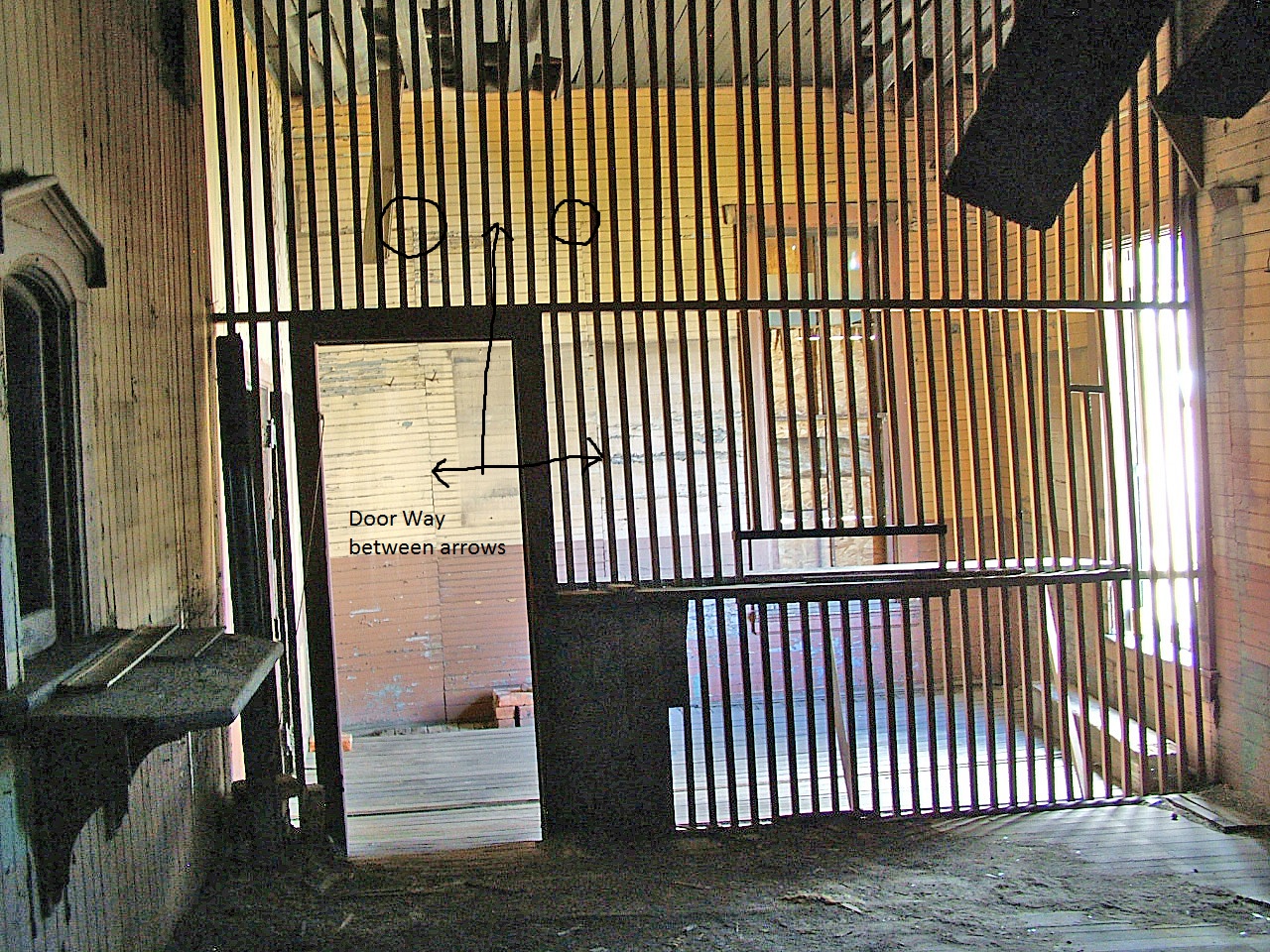 "Photos above used by permission Copyright Ken Smith Photography All Rights Reserved.” www.steamandmorephotography.com The two pieces of Gilman architrave are shown above in the photo of the green baggage room. Again, the piece on the wall was fixed with such haste that the mitre was left as was. The piece across the ceiling ends at the corner of the room inside the baggage room. Now I have to be thankful to the owner of the depot at this point for providing me the files of the Renovation of the building so that I could eventually work out why these pieces of architrave were positioned as they are. I had the plan file printed so that I could take scale measurements to make comparisons. And so I now refer to the end wall (West wall) of the office. There are two panels in that wall with narrower cladding. One I marked as a door. The other one to the left side. It could have been that the door was where the panel was to the left instead. It does not matter. The point is the shape of that wall minus the two panels. In that form, going on the architectural drawings, the west wall of the office fits into where the architraves in the baggage room have been placed.  If that is not enough to make your head spin, the wall with doorway in the corner of the baggage room which is positioned North South direction is exactly half the internal width of the depot, East West direction. Does the mind boggle?  In the photo below, please disregard the note about turning the office. I was still beginning to work things out. Yes, it was a point for lifting the depot and the photo of the west wall shows the corresponding hole in the floor. I will go into all that again later. A bit hard to discern but there is a join in the wall where the green paint is. That also is exactly the centre line of the depot. Underneath the roof ridge line. I do suspect that the joins in the cladding at this point do not go all the way to the ceiling here because cladding was removed when the wall was altered for the roof to run in the other direction. This latter bit is speculation but that is the centreline of the depot and the roof was changed. I am saying now as I have said before, The depot was moved away from the hotel to enable the second extension. That is the kitchen diner extension. So look now at this third piece of architectural design. This window/doorway. It would have been close to if not exactly directly below window at the end of the hallway upstairs. The hallway that was at the rear of the 20& a bit feet deep extension that joined the two hotels. But we know there was no doorway through the kitchen to the depot! But what about before the kitchen diner extension was built? John  |
|
Administrator
|
Interesting. Thanks, John. I remember your Depot posts from years ago.
|
|
Thank you for the response Mike, it is appreciated.
I will lead on from my last post as it will kind of link in. I found another photo of the window in the North wall that I suspect could have been access to the Original DSP&P Hotel before what I will refer to as the second stage or 99&1/3ft extension. The architraves do extend to the floor as a doorway would. Also, the grooves of the panelling under the window do not line up with the grooves to the outside of the architrave. It is a clear indication that this was once a doorway. Also, given that this section of wall ends in line with the rear of the depot, it indicates that this is a half wall also. So that is an indication that this window/door is post the original construction. (I don't believe these walls were original external walls of the depot previously. Rather, internal walls. It's complicated.) That is, bearing in mind that I am convinced the buildings involved were moved to Como in pieces. Which is the main reason I am here. To demonstrate that. I can not tell anybody that this was a door entrance to the hotel before the kitchen extension. It just looks a whole lot like that to my mind.  Below again. I have found a better wall showing the join in the North wall which is under the current roof ridge line. In this photo if you are on a monitor will show more clearly, a step in the wall cladding can be seen towards the top. This is not uncommon and I will point it out again as we go along. Anyway, the hole in the floor and the ceiling above out of sight in this photo are on this side of the roof ridge line. For future reference.  Below again. Here then is a photo looking towards the back of the office towards the room I call the Sleeping Quarters. The room that started all the contention. I will come back to this but just take note that the painted vertical boards on that wall are staggered. Like they were nailed on after they were painted. What I really want to point out is the location of the hole in the floor where the oak counter is sticking out of. Consider that between these two holes in the floor, it would very possibly be the balancing point of the depot this end were two slings dropped down to loop a bearer under the floor to lift this end of the building. If you know the building then you might be able to guesstimate the distance between the two holes. Since I know that the depot is 20'3" deep external and I can see the join of the wall, I am going to guesstimate around 15ft. Moving on... 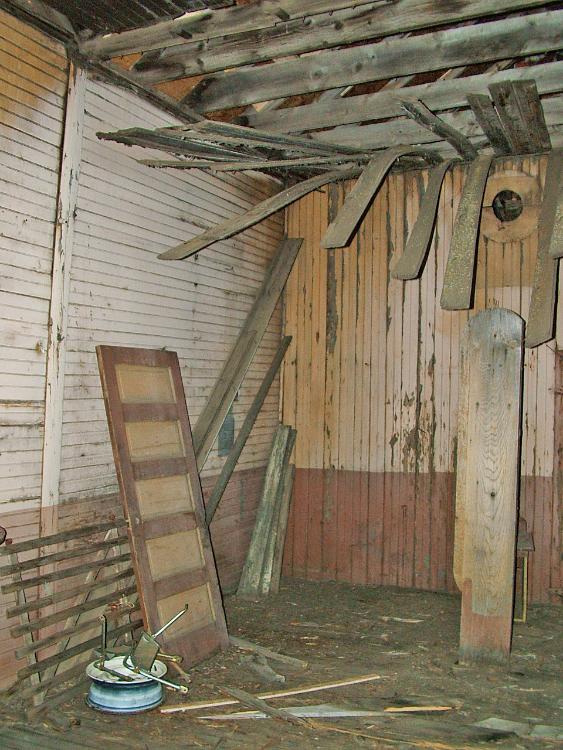 Below again. As opposed to the holes in the floor of the office behind the centre of the building, In the photo below here are two white patches. I think it is clear that these patches are replaced tiles. A counterbalance point to lift the this end of the building in the same manner as the office end. But what about the middle? There appears to be a patch there as well. Slightly left of centre and on this side.  In the photo below in the wall showing the original ticket room window can be seen a join in the wall. And the cladding join is staggered here in this wall also. In the corner, in the ceiling is a square hole patch. The patch is on the rear side of the roof ridge line as opposed the the patch just referred to in the last photo. But, they are the same distance along the building which I know because I have the plans. You will have to make your own minds up if there is a corresponding patch in the floor. I think that there is and it is in line with the join in the wall. (Incidentally, I believe very strongly that the wall with the doorway, the entrance to the room called the Oil Room was formerly an external wall. Why? Because the thickness of the wall looking through the door jamb suggests the thickness of an outer wall. Because it appears to have had a window above that appears to to have been framed in with smaller lumber and partially clad. Because the wall is an exact half wall inside width of the depot. Because I was told that one of the walls inside this room had remnants of timber shingles still fixed to it. That will be one of two walls however.) 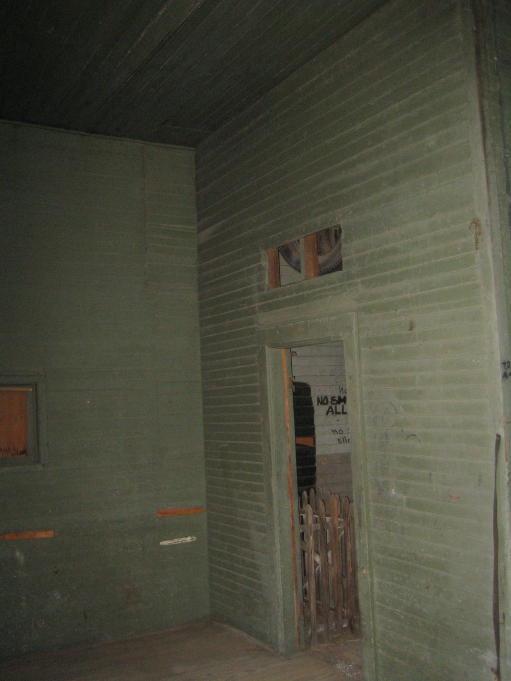 But we know that the depot was moved away from the Pacific Hotel already. I am just showing you that it was done already previously. And how I believe how, to the best of my abilities. ----------------- Now here I can be proved wrong because I don't know dates. I believe that this depot was not moved to Como until after at least mid summer 1881. After the Union Station opened. I believe that the first extension was (Joining the hotels together) at that stage that the windows were removed and the refuse of that reused in the depot. Therefore, stage one must have been announced a reasonable time previous to to the Summer of 1881. But I also say that the depot was built against the first stage of the DSP&P hotel before the Second, 99&1/3ft extension was announced. In other words the hotel kitchen extension which would have been the thirty odd feet deep and I can go into later. So, if anyone is game. What were the dates that these extension announcements were made? Thanks. John |
|
The sleeping quarters are what began a lot of controversy.
Upon joining various DSP&P groups I realised that I had read things online that were not generally known. One was that the sleeping quarters were built for the Dispatcher to use.  On making this comment to the group I received three responses. One responder said that they would never ever believe anything I said again, and also that the room had been the battery room. Another member of the DSP&P HS privately sent me the photos above and below. 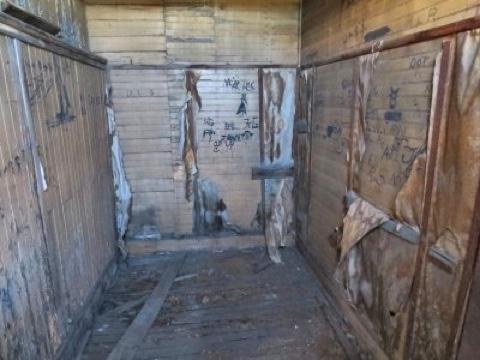 Clearly the room was not a battery room. Another member of the Society contacted me and expressed that they had thought the room had been made into a sleeping quarters at a later date. The same person expressed his puzzlement at the dividing wall from the office. The wall was only a certain hight and and on the office side it had had boards added to reach the full ceiling hight. This is the wall on the left in the above photo. I will discuss what I understand at this point in time. I have discussed half depot internal walls already. The low framed wall in question is exactly half a depot frame wall away from the back of the depot. I have measured the plan, I know. It is this distance away from the rear wall of the depot because the wall that returns from the rear of the depot is a half wall. Which explains why there is a window jammed in the corner. It is a wall from the original depot. 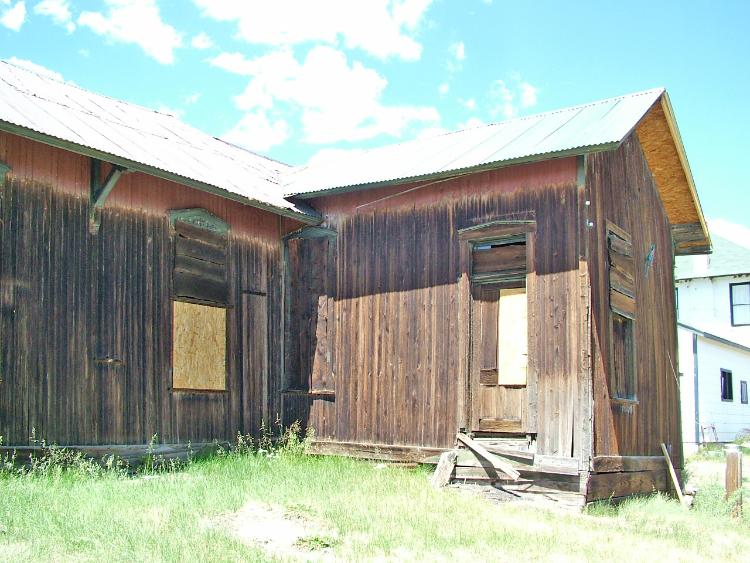 "Photo used by permission Copyright Ken Smith Photography All Rights Reserved.” www.steamandmorephotography.com I have a suspicion that the doorway in the above photo was once a window given the short cladding infill above it. The dividing room wall serves an extra purpose. It acts as a brace to hold the different sections of wall together. I have discussed the haphazard method of how pieces of the Gilman hotel were used in the depot. And it would be obvious that the Hotel would be closed at this time. Windows being removed upstairs and downstairs. Bedroom/s needing to be altered to make way for the 98.5 x 6ft hallway. Connecting to the existing east west hallway. Removing chimneys. And connecting the downstairs extension to the dining room as well. It should be safe to assume that the hotel would be closed and that the Dispatcher would need lodgings at this time. I suspect that this low wall came from broken down railroad cars. Like in the photo below. Maybe these very cars below. 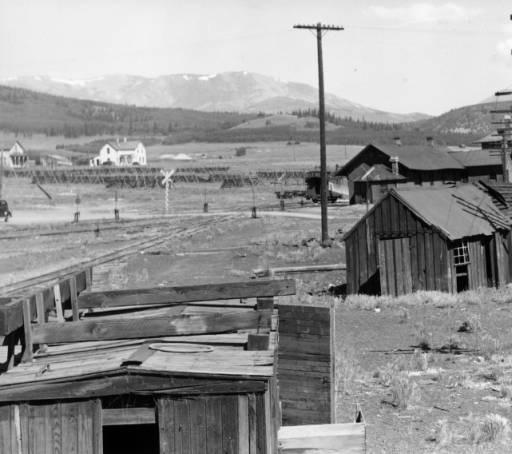 And then naturally as I say the Gilman windows were used used in the Switchman's shanty that little structure would have been added at the same time. I believe that the shanty also had walls from railroad cars. Cabooses or Work cars given the wall sizes next to the windows and the large door, maybe. Another member of the DSP&P HS sent me the drawings done many years ago before the shanty collapsed. The drawings were prepared by architect Maynard R Rorman. The roof of the shanty was the same width as that of the office roof. Well, before it was changed. The same width of the roof over the sleeping quarters. Look back at my last post to observe that the ceiling cladding over the rear and front of the building are running in the same direction. As they normally would before the roof was changed. The roof of the building that this building came from was long. There was plenty of roof to share.  So that is the sleeping quarters and shanty using Railroad cars. But originally, the vestibule out front was also a railroad car, with a round roof. But I was assured that it was not by time the vestibule was removed.  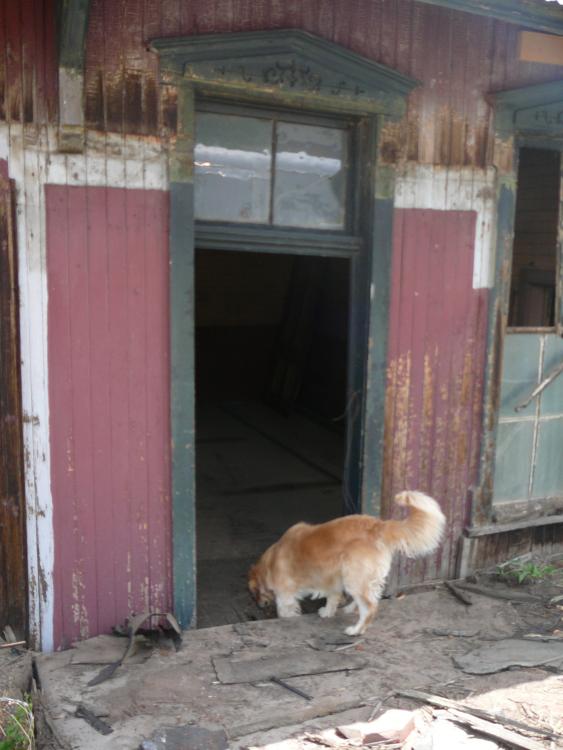 The silhouettes that I see in the above photos are first the frame of a round roof car against a white wall. The cladding knocked off of coarse. After that I see what looks like a flat roof being built on top of the round roof which left an inaccessible olive green area unable to be painted over. I think we should keep in mind that these were very poor and struggling times. The reason why John Evans sold his railroad to Jay Gould of the UP. Gould made his fortune taking over Railroads as he expanded. And his first investment into the DSP&P was with the supply of materials and equipment although it is not known what that was. This was just before the railroad reached Como, you will read in MC Poor's book. It is my reasoning for why all the Engine House doors are different. Surplus equipment. 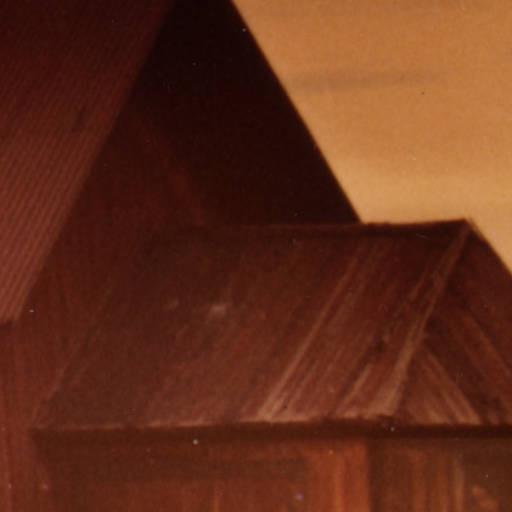 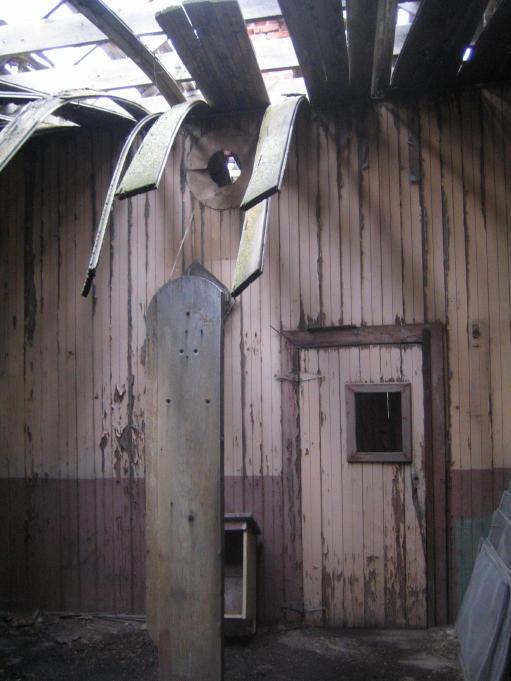 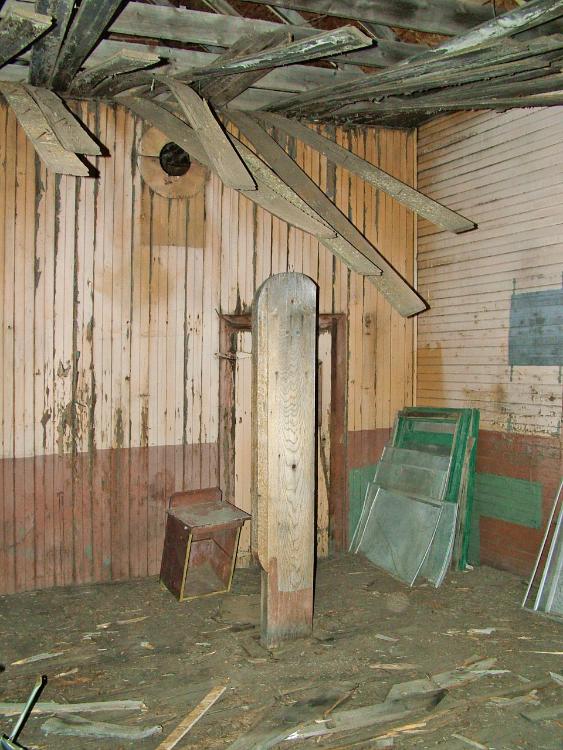 Photo below shows the office ceiling cladding running in the same direction.  "Photos above used by permission Copyright Ken Smith Photography All Rights Reserved.” www.steamandmorephotography.comJohn |
«
Return to C&Sng Discussion Forum
|
1 view|%1 views
| Free forum by Nabble | Edit this page |

